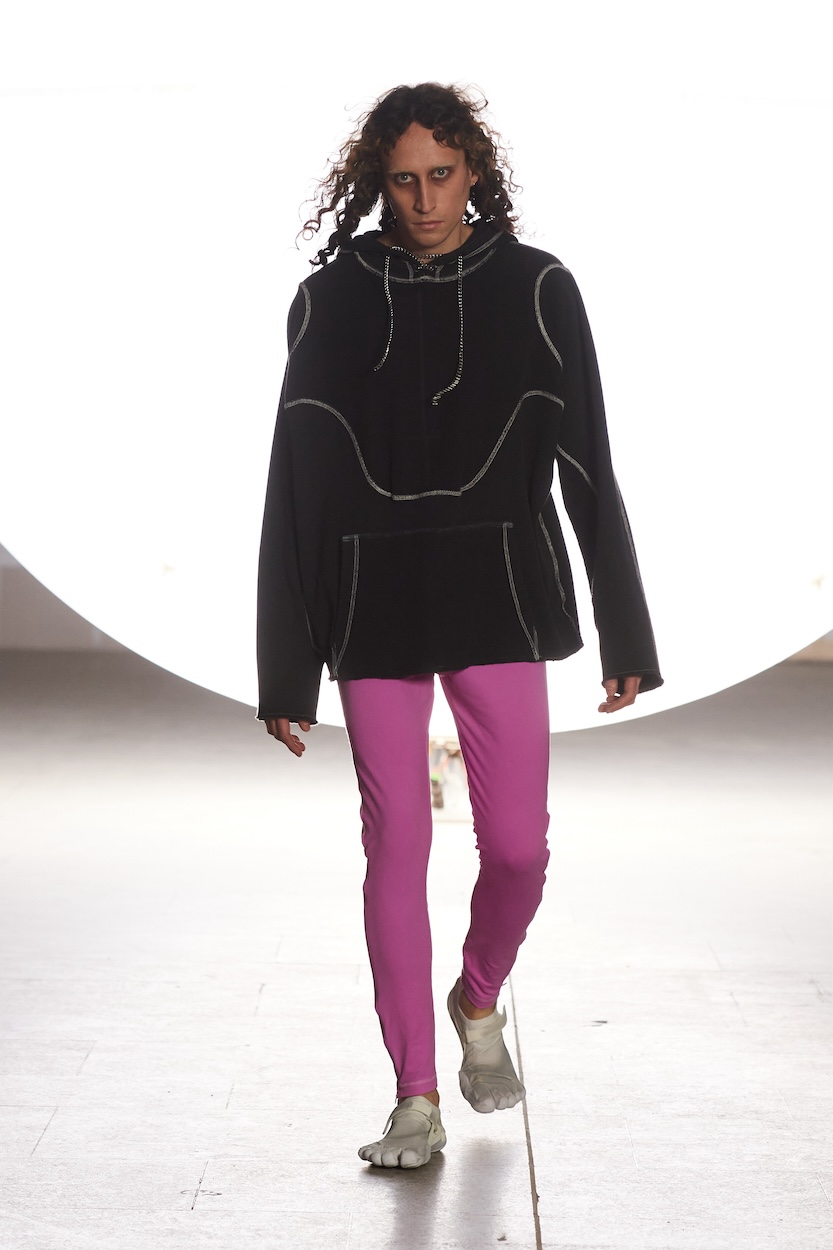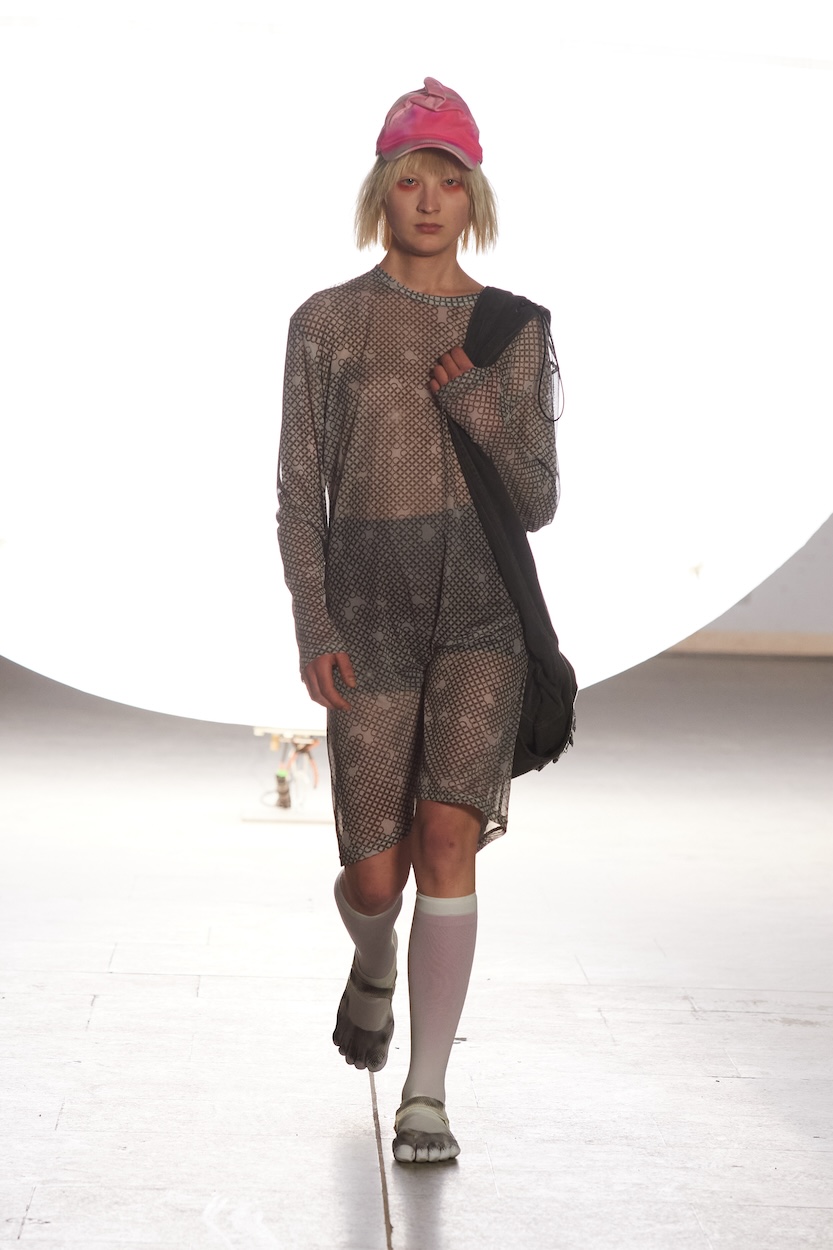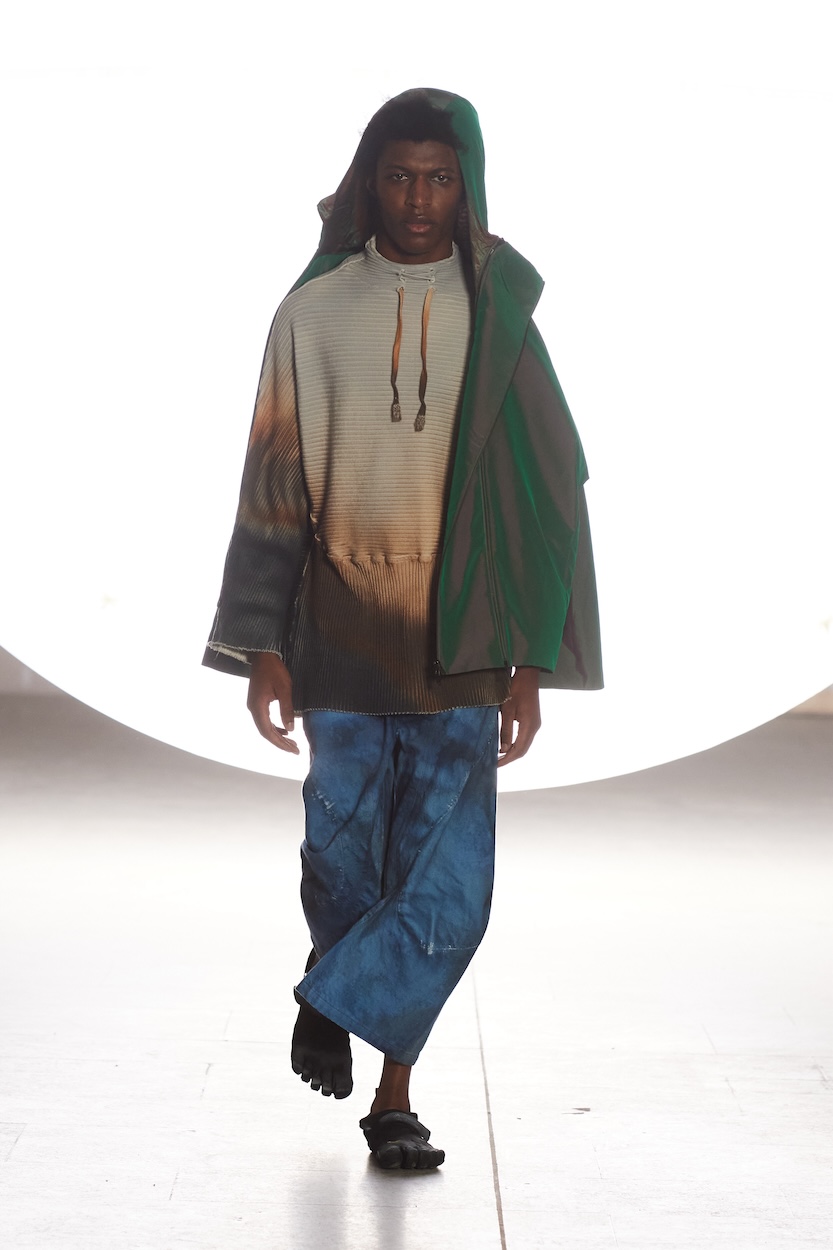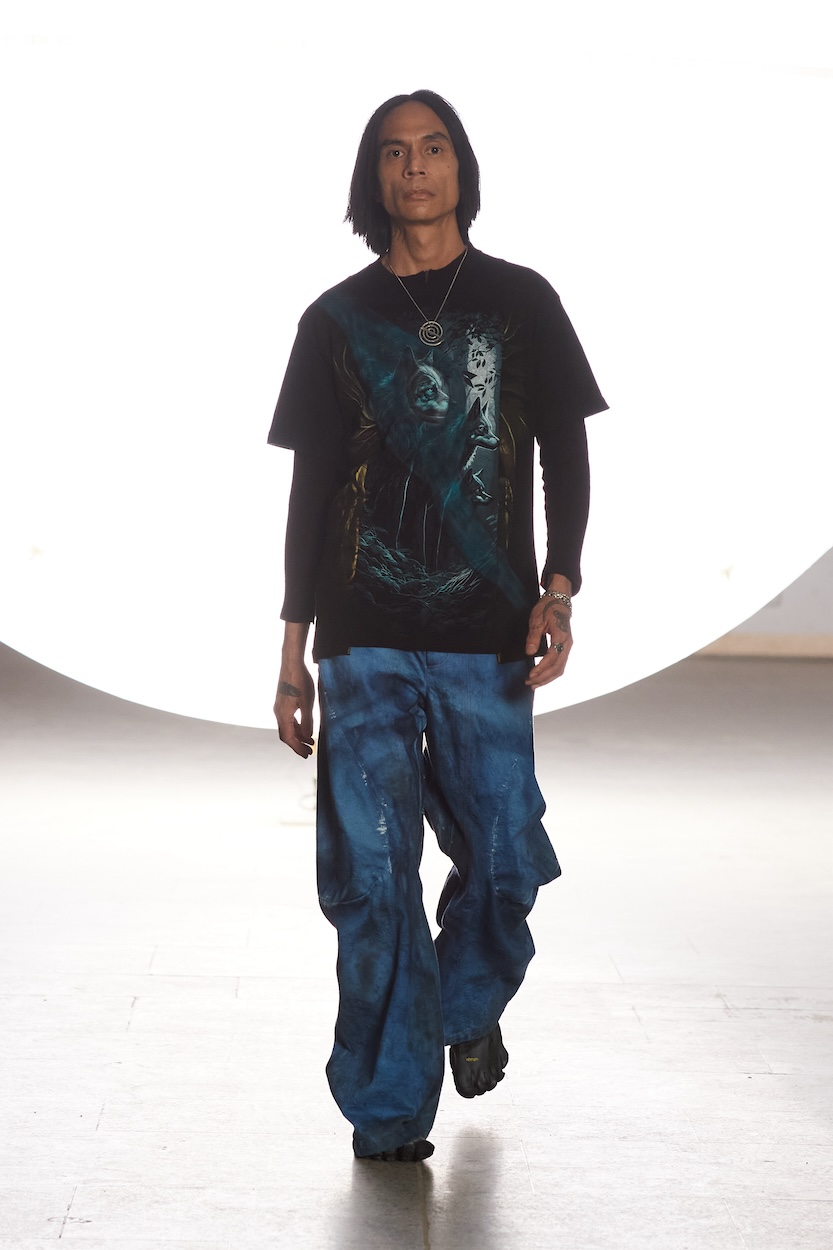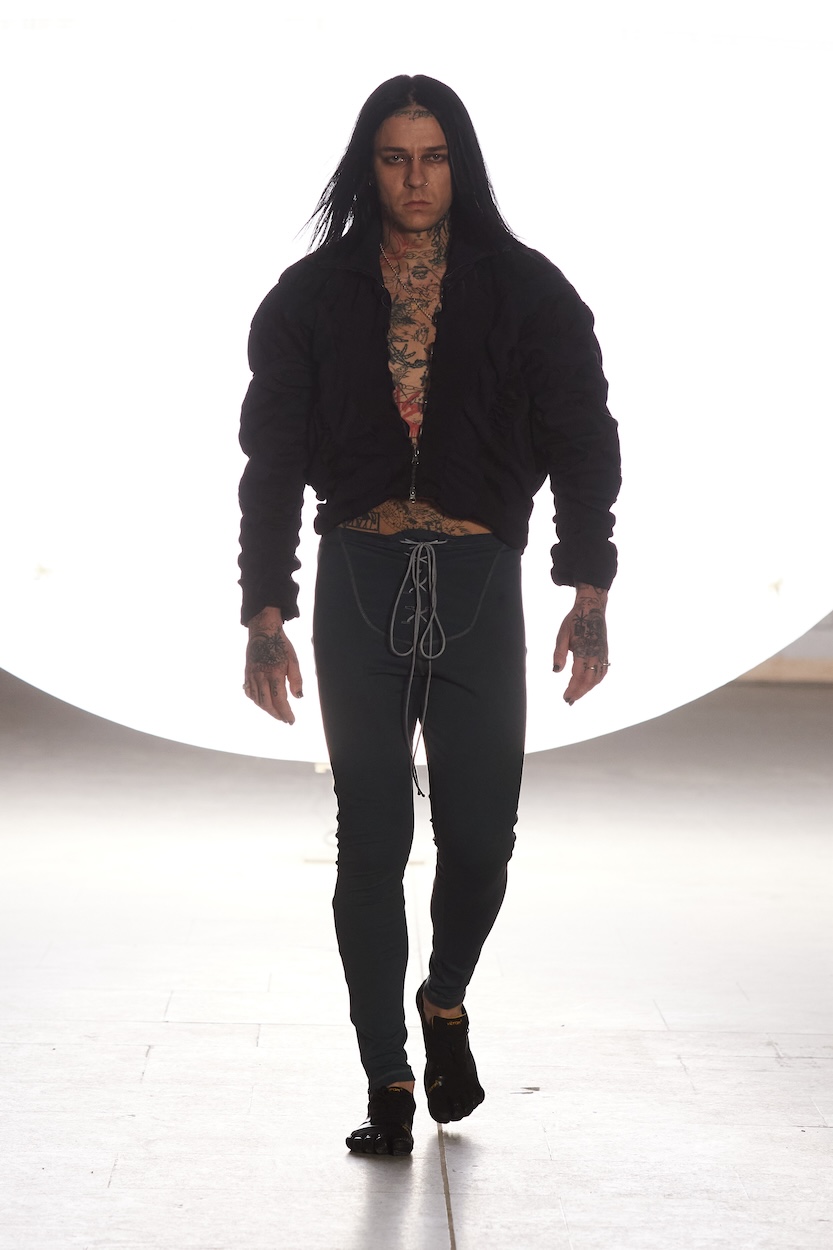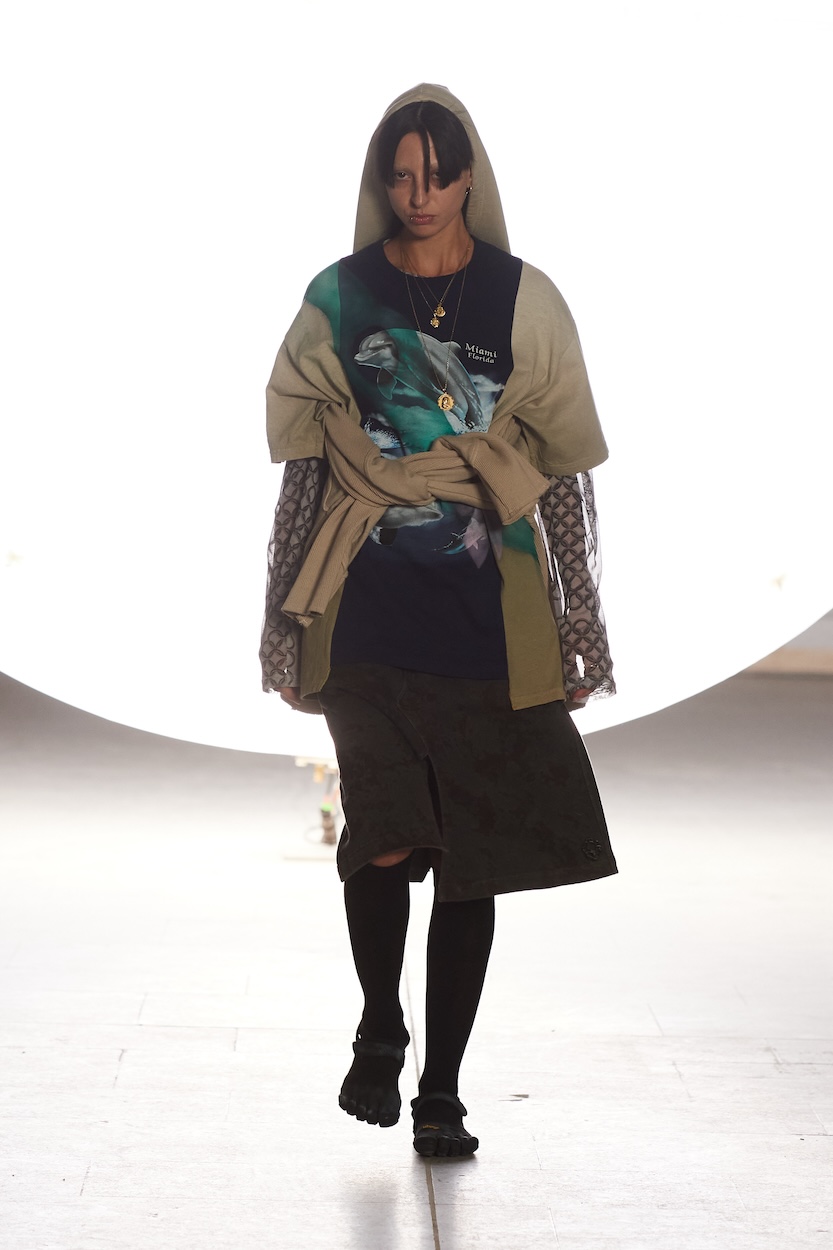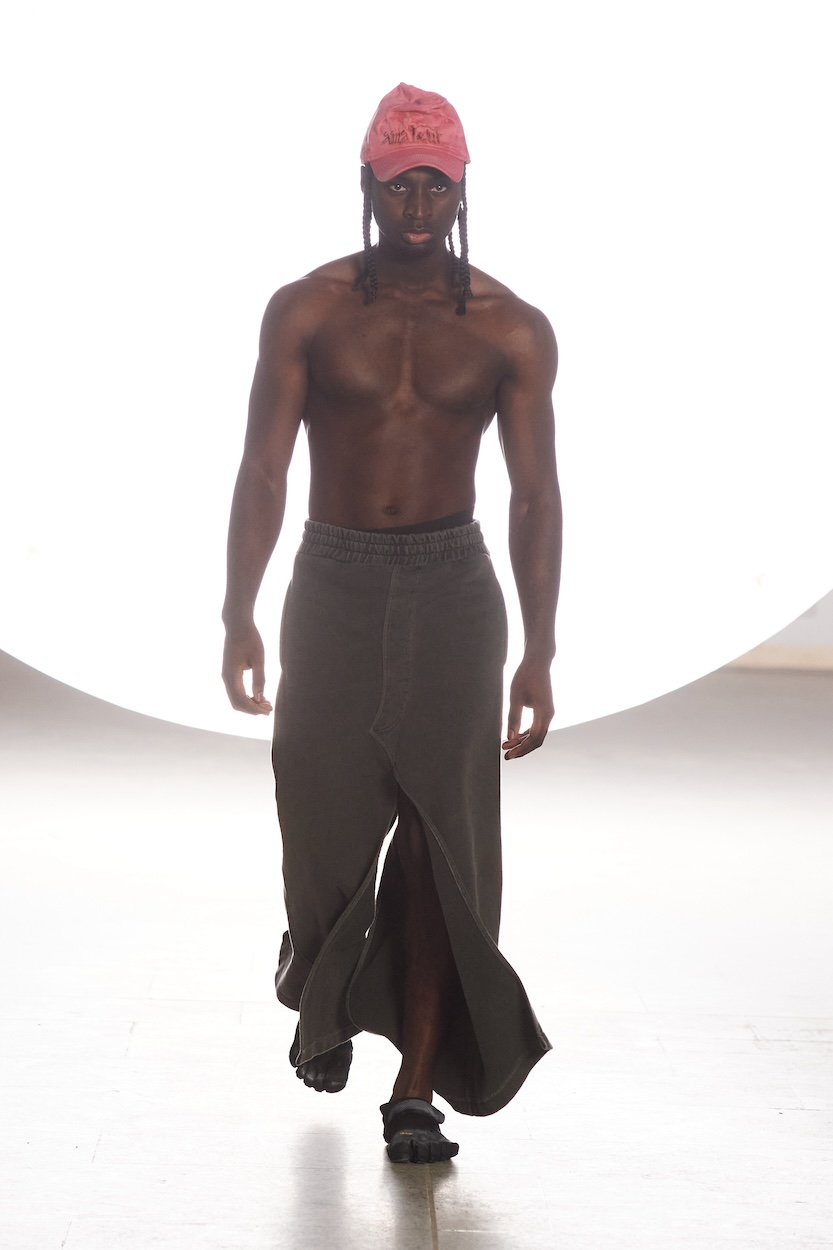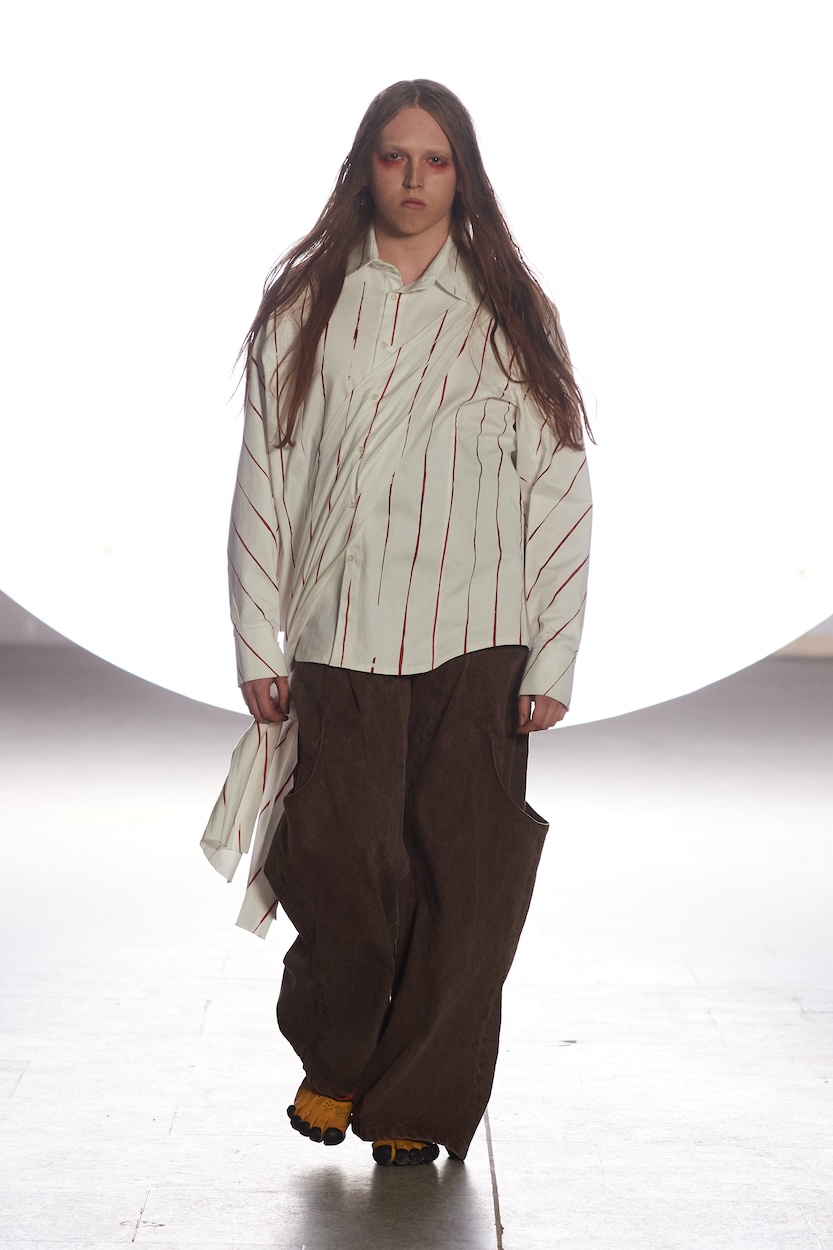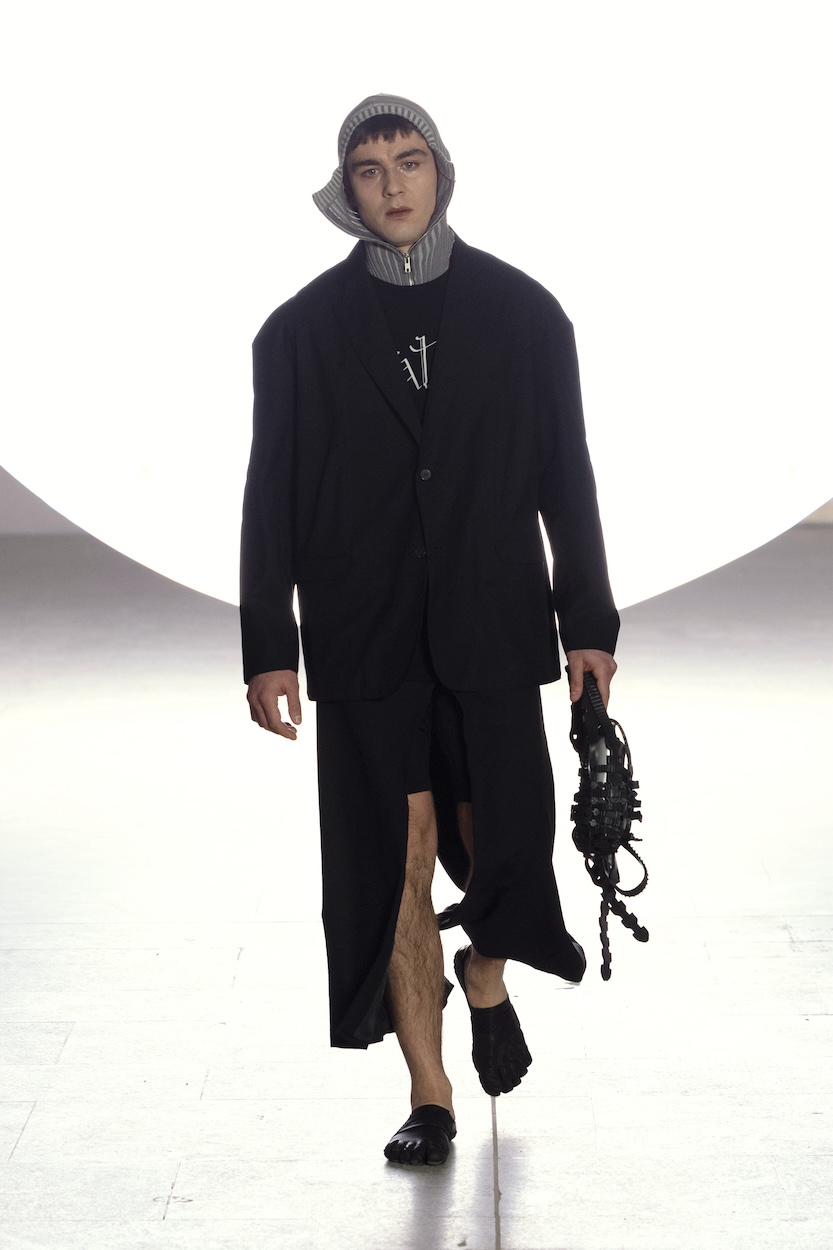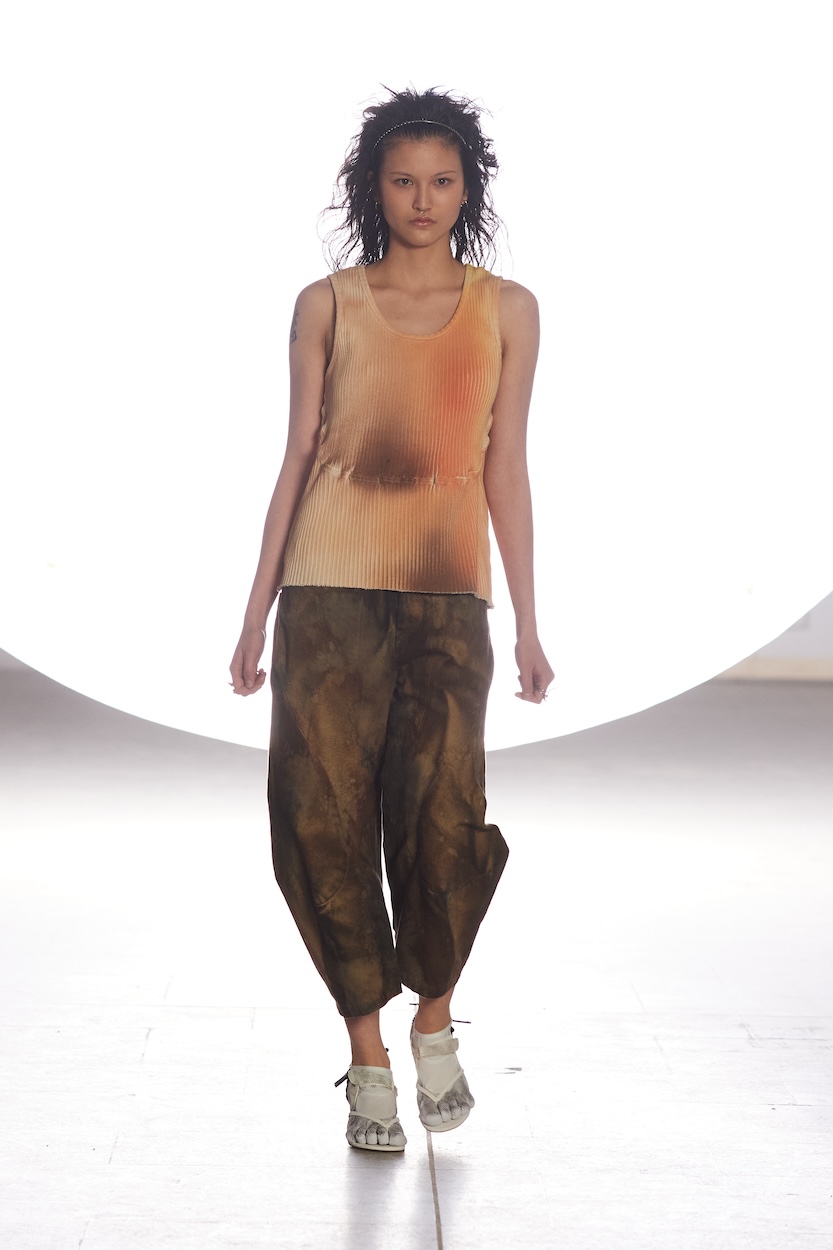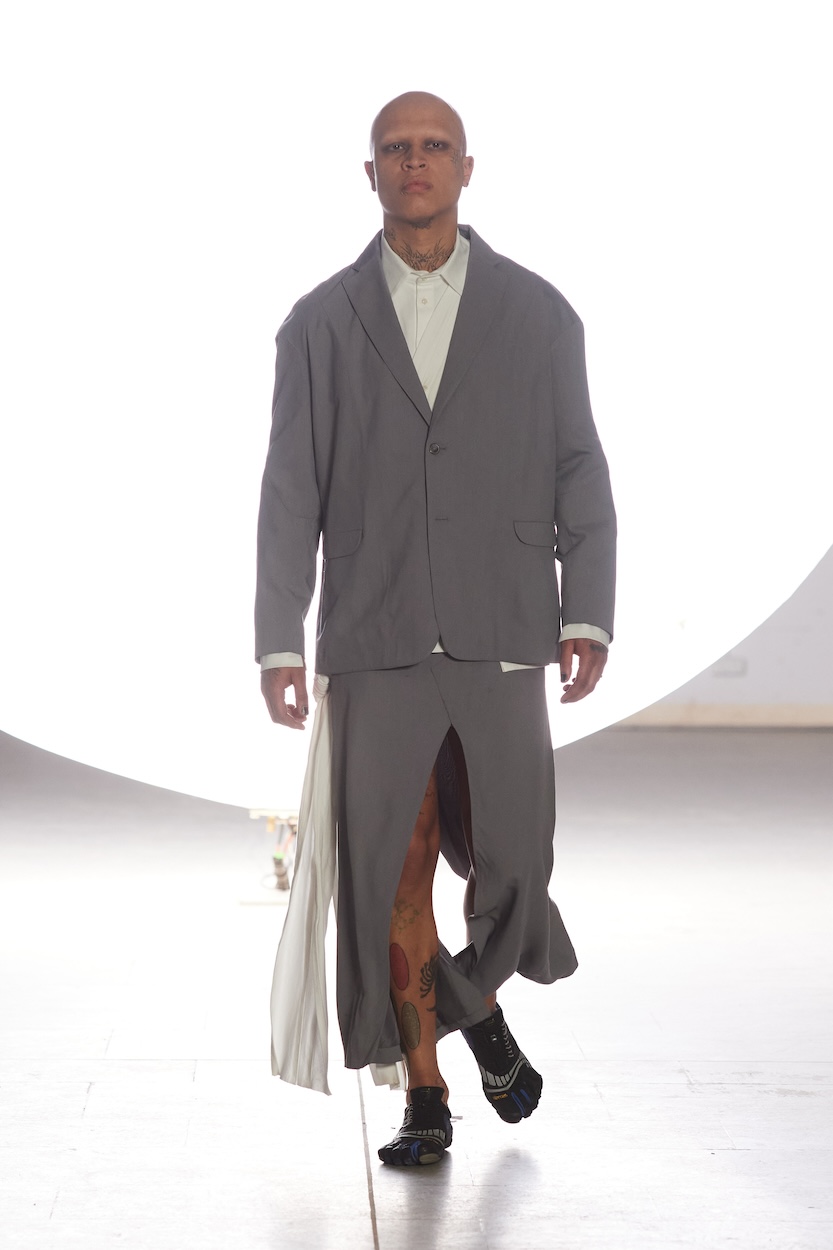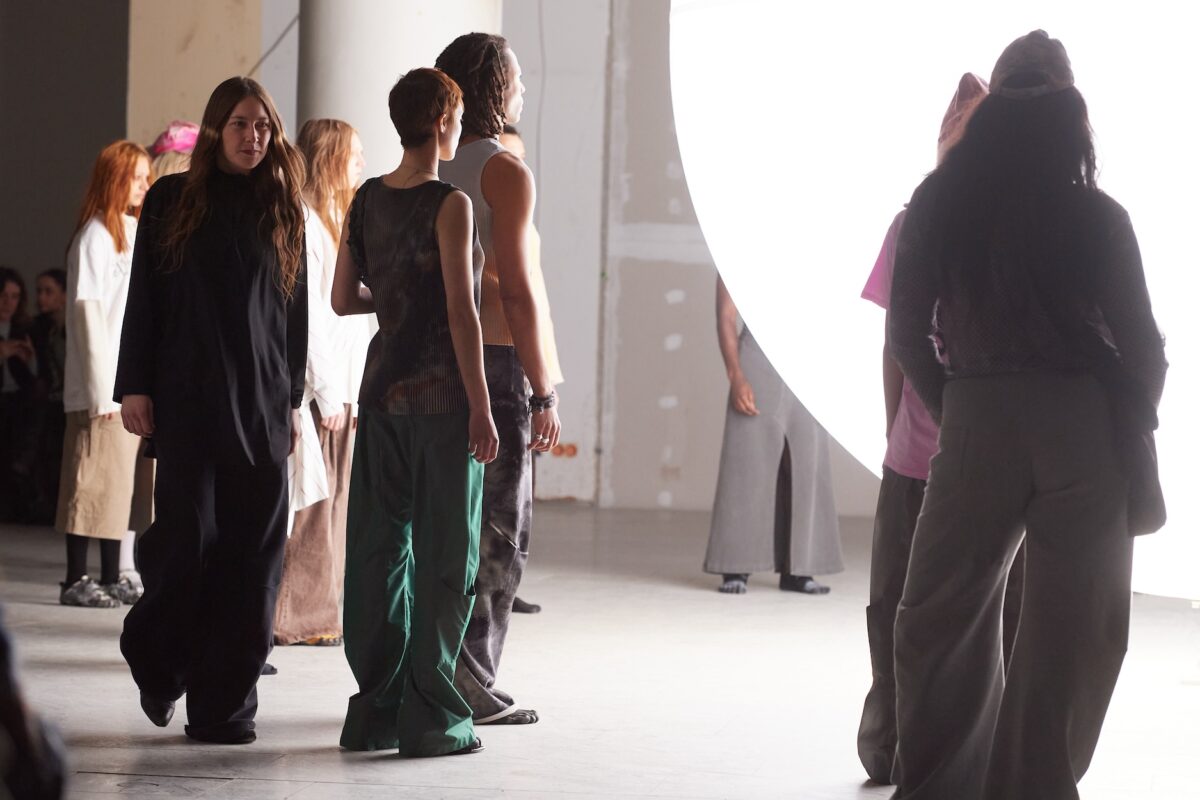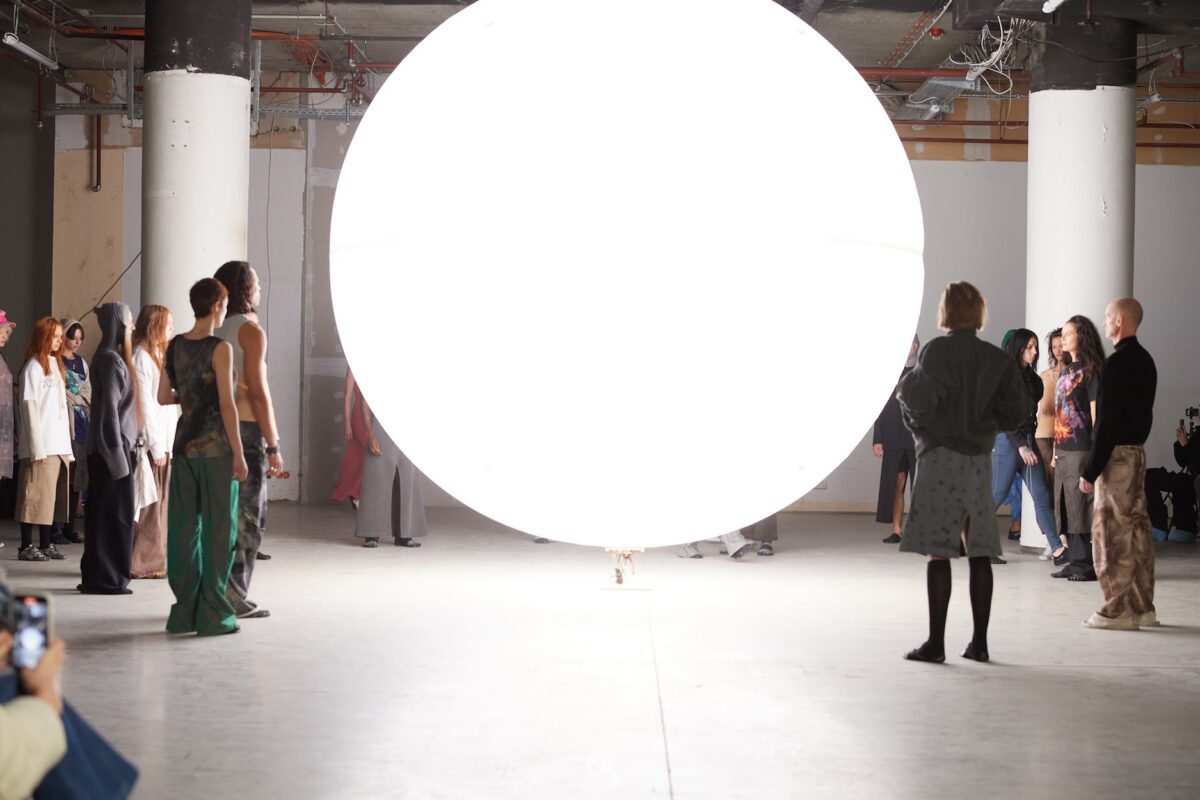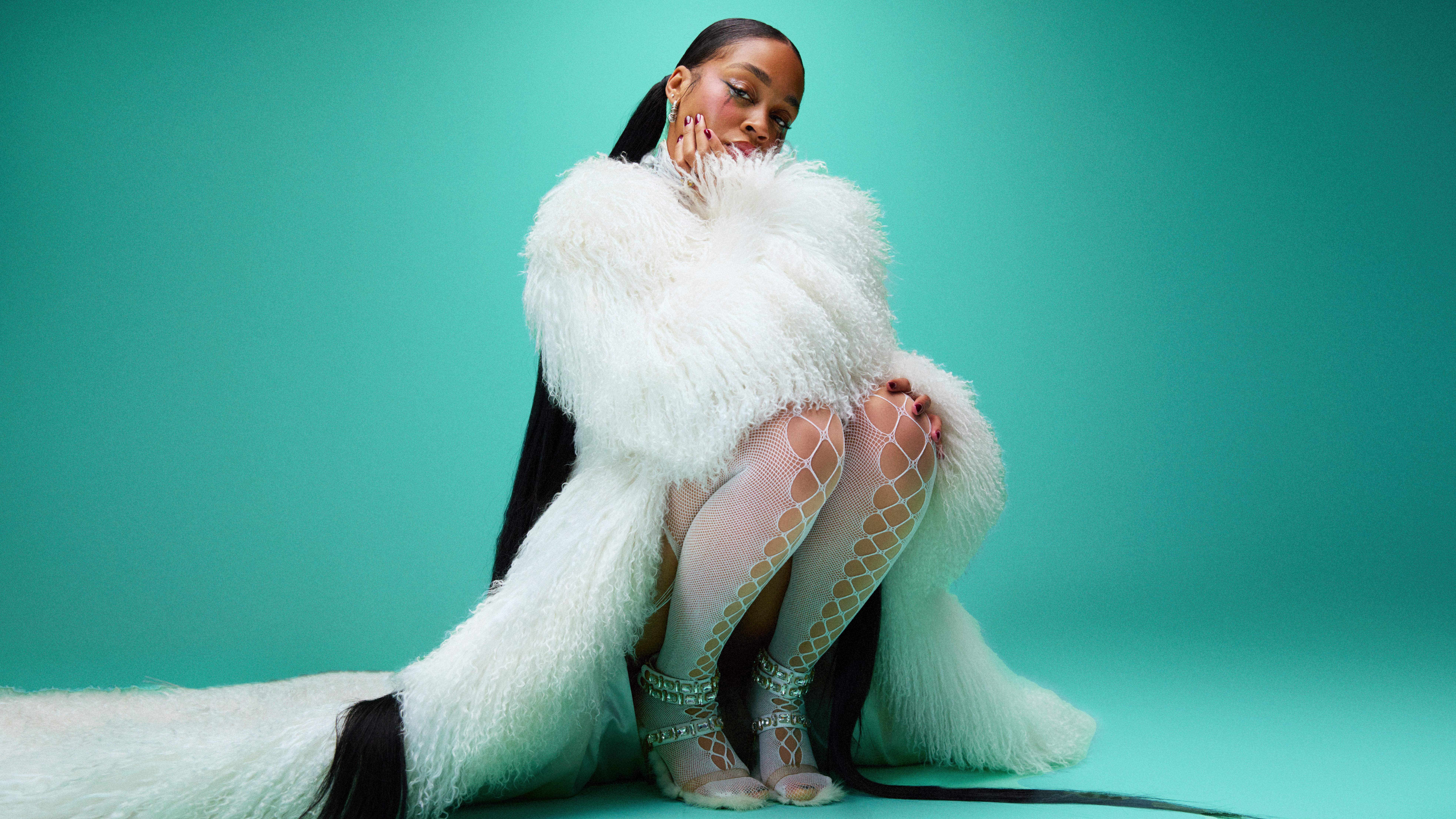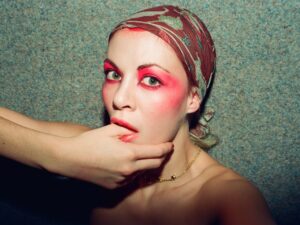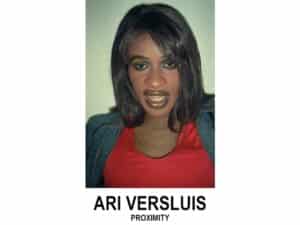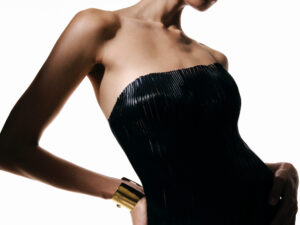Berlin Fashion Week Highlight: Lueder.
ANXIOUS MEN AND THERAPEUTIC FASHION: IN CONVERSATION WITH MARIE LUEDER
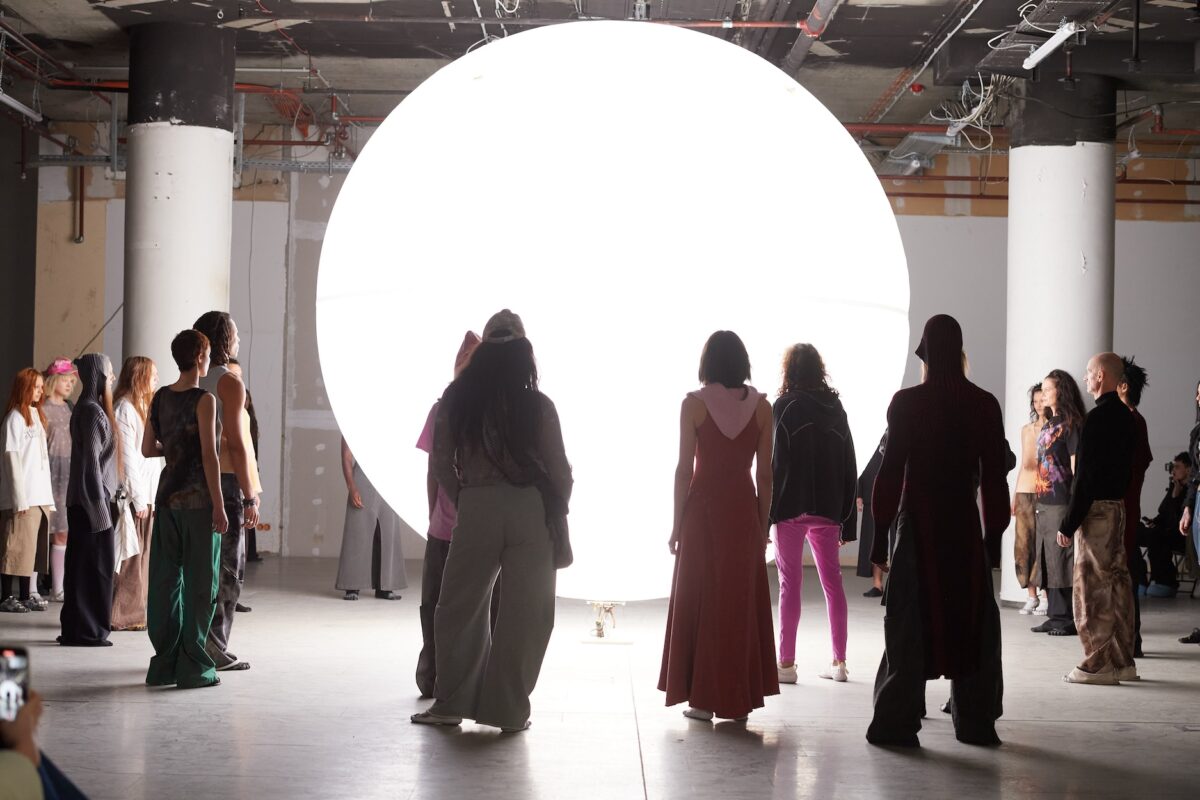
The collection included flare jeans, armor hoodies, tank tops, sweaters, and classic joggers, alongside customized and repurposed Vibram 5-finger shoes. The color scheme draws inspiration from the transformative stages of burning wood, embodying the cycles of fire, ashes, and rebirth observed in nature. This is complemented by deep petrol hues, hints of pink, blood-red stripes, and engineered knits in black. Additionally, greys and blacks are incorporated to reinvent the traditional LUEDER suits. At the heart of Lueder’s ethos lies a commitment to community collaboration. The brand has joined forces with esteemed partners such as Vibram 5 Fingers for footwear, and talented artists including Mia Violet for airbrushing, 4FSB for caps, Théo Casciani and Esther Mejbowski for myth building and graphic design, Tom Schneider for show design, Rat Section for music, and Marius Perraud for jewelry.
Fräulein: You’re currently in London and have already showcased your fashion there and in Paris. Why Berlin now? Do you feel like something exciting is happening there, and you want to be a partofit?
Marie Lueder: Well, it’s actually quite straightforward. Yes, I feel like something is happening in Berlin, and it’s fantastic that REFERENCE (STUDIOS) has initiated this new format. What’s also important to me is that it maintains a performative character. I can create my set design, but having influence over it is crucial for me. Because at the point where I am right now, I still have a bit more to tell, and Berlin can provide me with that opportunity.
The title of the show is Mono Myth. What is it about?
That’s the Hero’s Journey. The myth is, in a way, Sun at Night. We tell the story that there’s a sun in the sky, both at night and during the day; it’s always there and never goes away. Like a big extra sun, a reality-fiction moment – that’s essentially our Mono Myth. This storyline will be reflected in the set design, the show, and the afterparty.
How did you get into fashion?
Well, from ages 6 to 12, I attended a kind of medieval camp – that was essentially the starting point. Dressing up was a big part of it, both at the camp and for my birthday since I celebrate during carnival season. Costumes were a significant part of my childhood. Together with my mother, I used to recreate outfits from books. Instead of just reading, I imagined myself being part of the story. We did a lot of research, and dressing up was a way for me to dive into another world. Understanding the functionality of clothing became important to me. That’s why I wanted to become a tailor and worked at the Hamburg State Opera. However, I was not satisfied by it. The structure and repetitiveness limited me. Everything had to be done as it was done a century ago. I completed the tailoring apprenticeship but focused solely on the suit – the pants and the jacket.
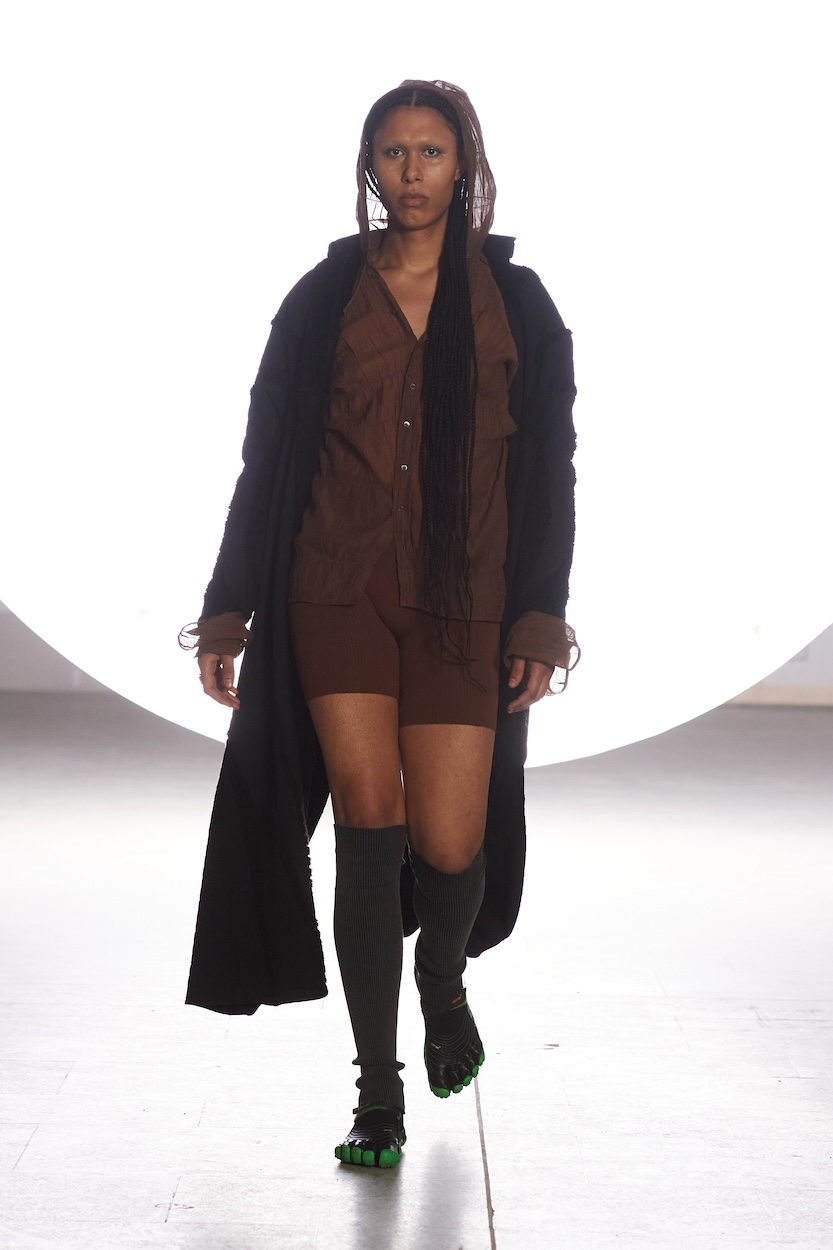
You describe your designs as “therapeutic menswear worn by female identifying people too” – what does that exactly mean, and how important is gender in the process of creating fashion?
It originally started with menswear, simply because I had no interest in dressing myself. I wanted to dress other people and found it most interesting to dress those for whom I felt there wasn’t much available. Male friends or boyfriends told me that they were missing variety in menswear. Some of these men struggled with depression or anxiety, and I wanted to help them navigate life without it being too overwhelming. I loved that challenge. Over time, I discovered that this caregiving aspect fascinated me. That was when I eventually named my designs Mental Armour, as this term combines the medieval essence with the aspect of caring. As time went on, I realized that I also wanted to wear this clothing myself, as did many of my female friends. And in that process, I noticed that gender didn’t really matter. But pragmatically, it’s important when creating the cuts that a female-identifying body fits differently than a male-identifying body. You have to consider that. So, I developed certain systems to facilitate this. For example, the rounded waistlines on the trousers make the pieces fit well on both bodies. Or, on a jacket, you can remove a middle section to make it two and a half sizes smaller. You try to find compromises when you don’t have the budget to offer a thousand sizes or cuts. That’s why I would say it’s genderless. But I think it would better to call it menswear that can also be worn by female- identifying bodies. For me, unisex is more like a shapeless oversized t-shirt. Our clothing is quite defined; for example, the hoodies and everything I make oversized but the access fabric has purpose and is engineered. It matters how it fits and how the folds fall.
Were there any specific role models for you in this regard, or in the fashion industry in general?
I admire Martine Rose. I always find it amazing how every piece, whether designed for females or males, fits on both bodies and works wonderfully. Also, Vivienne Westwood, I love the way her pieces are tailored.
This is your first catwalk show. How important was the support you received from Berlin Fashion Week for this?
The support from Berlin Fashion Week was crucial, and I thought, why not take advantage of it, if there’s financial backing? I also have an amazing team, and with their help, trust in me, and the opportunity to grow together, I thought it would be a good next step. I’m at a point where I might otherwise stagnate. I love the idea of doing a runway show, but in my own way. We’ve thought of a few things that also have a performative element, and I hope everything works out. It’s also a challenge to break down all your thoughts into a 12 to 15-minute show and at the same time to demonstrate to potential buyers that the clothing works on the catwalk.
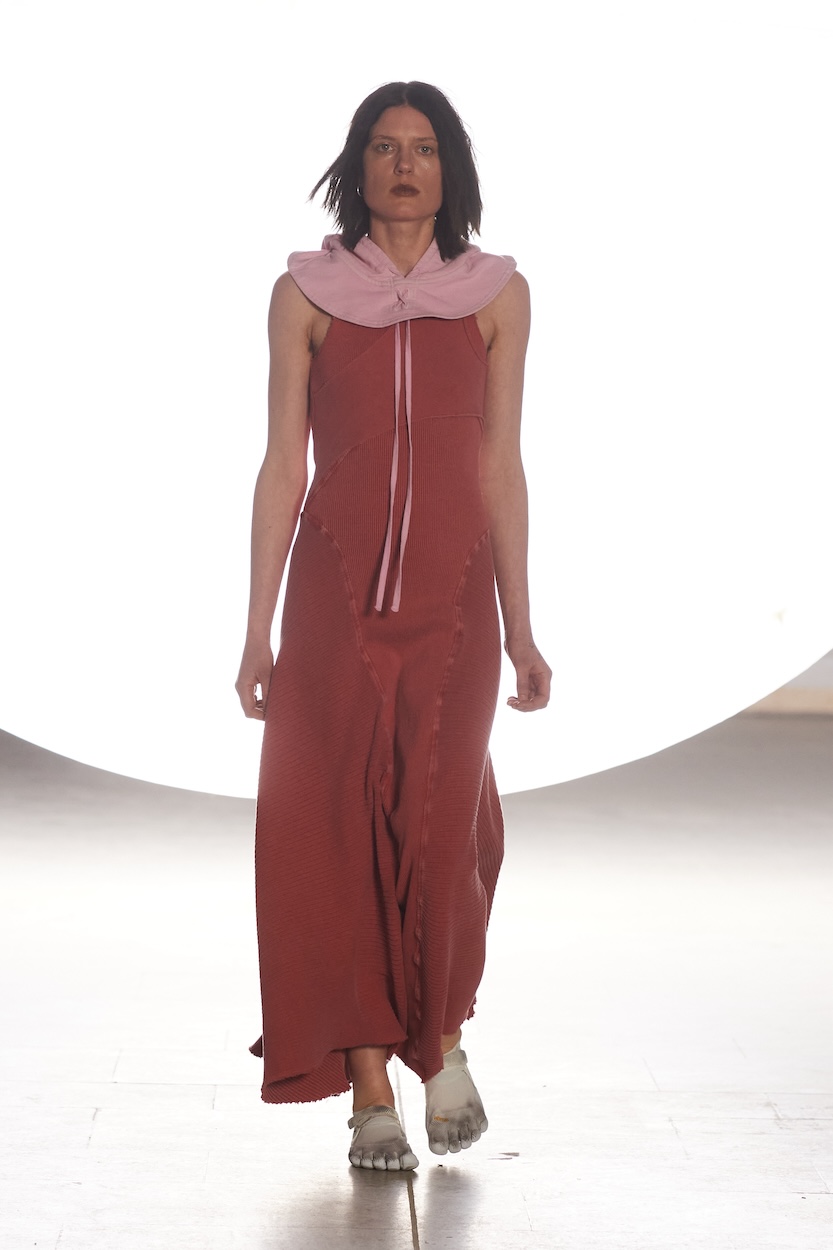
We briefly discussed the name of the show. What exactly is the main inspiration behind it?
The Hero’s Journey, this Mono Myth, is a cycle with several stages. Each individual sets goals. For example, I came from my small village to Hamburg and wanted to become a tailor. Then I realized it’s not 100% my thing, but I made many friends and had a good time. There are always new stages, new quests, new tasks. Sometimes you realize: „Ah, this isn’t for me.“ Or you fail. And then you start again. I found this rhythm interesting and adapted various elements of this journey to the collection. For instance, if you travel from point A to point B, with functional clothing, I consider what focus it should have. In London, you won’t need to wear a fully waterproof jacket, but a one that is at least water-repellent and still maintains breathability. I created a dress, thinking about female role models, strong women and female warriors. For the dresses, I pushed for a one-size-fits-all silhouette, while considering different female sizes. It’s very feminine, quite different from my usual theme, challenging and exciting, and it worked well. I integrated certain techniques from my hoodies to create a sophisticated dress. This was important for the process.
The suit is still a difficult topic for me, having learned it in a very classical way. I find it somehow perfect as it is, and you can’t do much to it. I don’t want to artificially design the suit, but I wear it for specific reasons, perhaps to be taken seriously or to look official or simply because it’s an easy garment that always looks good. It embodies the idea of almost a kind of uniform. So, I redesigned the suit with seams, eliminating shoulder pads, not reinforcing but simplifying it more like a shell and idea of a garment. We want to see if it works. It was a process, and I’m curious about what will happen in the next sessions. I also wanted to create some pieces that could truly work for celebrity styling and that I could wear out to events myself because it should be sometimes elegant in a way.
How do you integrate sustainable practices into your processes? I’ve read that you use zero- waste methods to some extent?
Yes, for T-shirts and knits, we follow zero-waste principles. I used to upcycle everything in the entire collection, but unfortunately, it only works to a certain extent because shops simply don’t want to buy one offs. So, I’m trying to find a mix with sustainable fabrics.
Currently, all our nylon pieces are made from eco-nylon, which is produced from old plastic bottles. The cotton used for jerseys and jeans is organic cotton. We try to produce on-demand, and we have a small factory in London. That’s why I still produce in England because it allows me not to buy 300 pieces instead of 30. It’s more expensive, but I have more control, and I don’t need to contribute to overproduction. It’s a compromise, but ideally, I’d like to produce only on-demand, which is working relatively well. However, I’m unsure about the future with larger quantities. The real issue is not with us but with what happens in the shops. If the shop puts items on sale, they often end up being burned. There needs to be more communication between us and the shops, and more needs to happen in that regard. For example, I recently told a major stockist that I’d like to go back to doing only one collection per year. They laughed it off and said it’s not possible. I find it unfortunate because it would be better for us, to give us more time and allow for gradual growth, which I think is the best way.
For this collection, the idea was more significant, with a catwalk and offering more including more colors and variants. By having more pieces, you can tell the story better, and I believe it worked well in Paris for our showroom with breakfast. international – it was well-received.
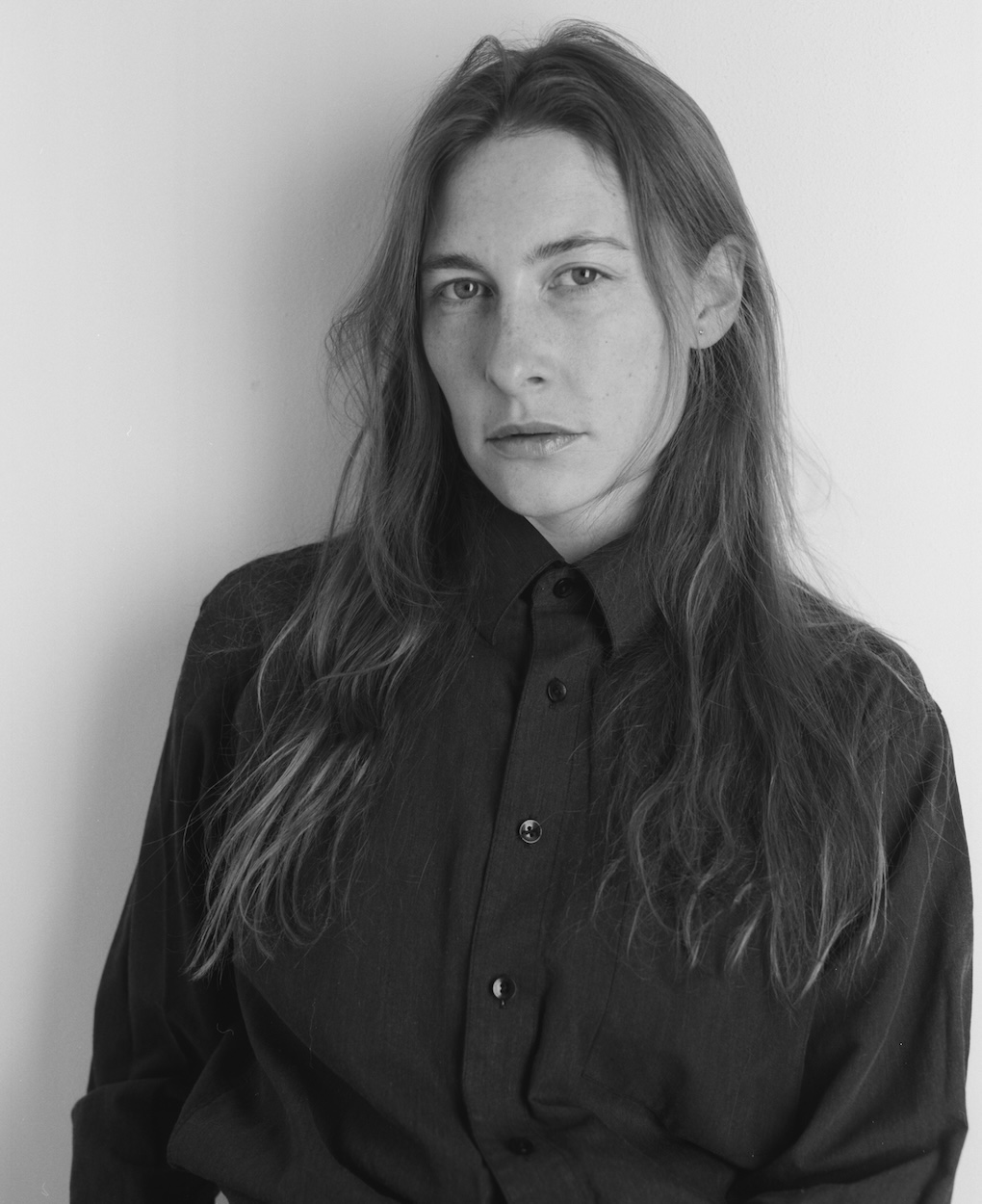
Portrait: Marie Lueder
As a young designer, you not only have to work creatively and design but also wear various hats like a businesswoman, creator, etc. How challenging is such a broad range of tasks, and how do you manage it?
It’s extremely exhausting and only possible with a good team. I’m really happy that I hired someone this month. Otherwise, I mainly work with temporary help, and freelancers, and I always try to ensure that I can give them as much as possible. But yes, it’s challenging to do it alone. You have to delegate responsibility as the only option and try not to work 24 hours every day because that’s simply not sustainable. But right now, it is what it is, and I’ve learned to manage it. You have to try to build a good team that believes in you. You have to be everything, do networking, and have advisors. It sometimes takes time to find the right ones, and it can also become too many, which is dangerous because then you stop trusting yourself. So, just stay in contact with people and do good work. There’s no master plan.
Are there specific places where your clothing is especially well-received? I could imagine that the aesthetic is quite popular in Asia.
Yes, definitely. Asia, Japan, and Korea are doing very well. That’s also due to the financial situation of some European countries.
You mentioned that in the current collection, there are more pieces suitable for celebrity styling. Is there someone you would love to see in your clothes?
Yes, Playboi Carti and we’ve sent something to him. I’ve managed to reach out to quite a few already, but sometimes you don’t get the pictures. Kendrick Lamar wore something once, but unfortunately, I never received the pictures.
What are the goals you’ve set for yourself this year?
This year, I would like to improve my production and delivery system. We still have some learning to do, I believe. I want to expand my team, quite pragmatically, and a bigger studio would be nice where it doesn’t rain inside. And I would like to collaborate with a shoe brand; that’s a definite focus.
And where do you see yourself in 5 years?
In 5 years, I don’t think I’ll still be in London. Definitely not, as I’d like to have a larger studio. Maybe just one collection per year, but five collaborations. That would be much cooler, working with other people and doing one collection per year. It seems better for the environment and better for us from my perspective. Then I want to expand into other areas like accessories and shoes. I have a friend who is a textile designer, and we worked with her material last year. Her idea is to create therapeutic clothing, like wellness for the body, with healing effects, especially for conditions like rheumatism or eczema. That’s the idea, to delve more into this area so that clothing can do more than just cover the body. That’s a significant point. I also want to talk more about it and maybe even teach. In five years, I definitely want to be teaching. Yeah, that would be cool.
Interview by KLAAS HAMMER
Photography by JAMES COCHRANE
